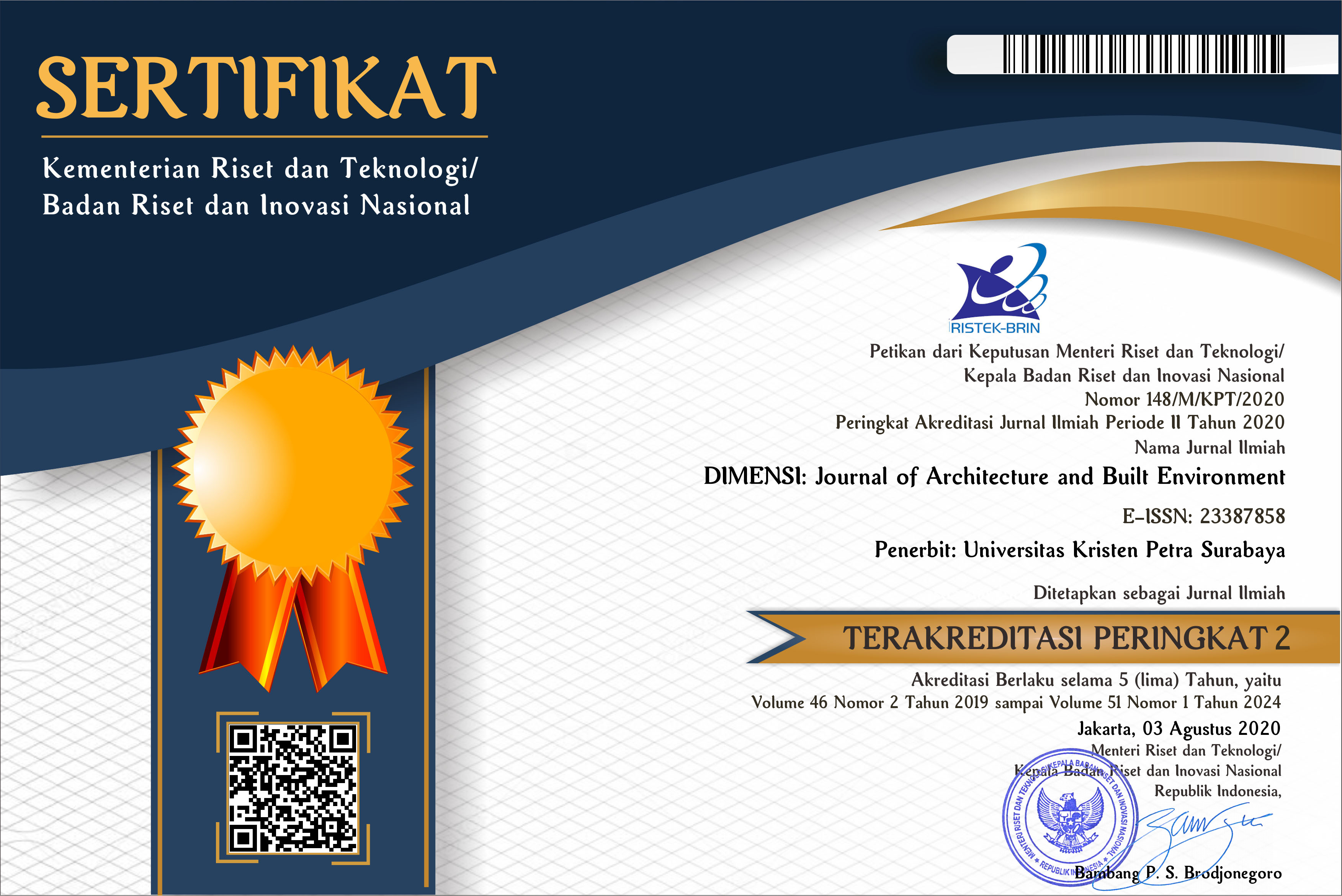EVALUATION OF REVERBERATION TIME IN THE CLASSROOM (CASE OF CLASSROOM AT DEPARTMENT OF ARCHITECTURE, UNIVERSITAS SEBELAS MARET)
 :
:
https://doi.org/10.9744/dimensi.43.2.93-100
Keywords:
Acoustic, material, reverberation time.Abstract
This study took place in three rooms in one building, give and take the external conditions were relatively similar. The study aims to observe the level of acoustic comfort and suggest strategies to improve the acoustic comfort by modifying materials and dimensions of the materials. The modification is much needed in practice since the user critize the acoustical comfort of the room. The method applied was simply measuring the condition of the rooms using laser distance meter and sound level meter, taking notes on the characteristic of the material used, and developing simulation based on several modifications in materials and dimensions of the materials. The result of the simulation was then being compared to the standart of reverberation time. The conclusion of the study was made into three points: (1) the acoustic condition in the rooms are indeed not meeting the standart to ensure users’ comfort, (2) the reverberation time is better when additional plasterboard ceiling are built, thus changing the rooms’ dimension; and (3) the noise in each room is not significantly reduced even after the additional ceiling built. The simulation in this study was done through the help of Ecotect 2011.Downloads
References
Departemen Pekerjaan Umum (2000). PEDOMAN Konstruksi dan Bangunan, Mitigasi Dampak Kebisingan Akibat Lalu Lintas Jalan. Jakarta: Departemen Pekerjaan Umum Accessed at http://www.pu.go.id/uploads/services/service20130717122457.pdf [CrossRef]
Egan, M. D. (1988). Concepts in Architectural Acoustic. New-Jersey: McGraw-Hill. [CrossRef]
Hansen, C. (tanpa angka tahun). Fundamental of Acoustics. South Australia: University of Adelaide. Accessed at www.who.int/occupational_health/publications/noise1.pdf [CrossRef]
Joestiono, H. & Asmoro, W.A. Desain Akustik Ruang Kelas Mengacu Pada Konsep Bangunan Hijau Kukuh Darmawan, ITS. Accessed at http://digilib.its.ac.id/public/ITS-paper-22346-2410105001-Paper.pdf [CrossRef]
L’Espérance, A., Boudreau, A., Gariépy, & Bacon, P. (2006). Noise reduction in daycare centresby reducing reverberation time Analyses and case [CrossRef]
studies. Subscription: 1-877-221-7046 accessed at http://www.irsst.qc.ca/media/documents/ pubirsst/R-463.pdf [CrossRef]
Mediastika, C.E. (2006). Akustika Bangunan; Prinsip dan Penerapannya di Indonesia. Edisi 1. Jakarta: Penerbit Erlangga [CrossRef]
Mediastika, C.E. (2006). Studi terhadap Reverberation time Pada ruang-Ruang pertemuan di UAJY (audiovisual, auditorium Kampus II dan auditorium kampus III) sebagai Indikator kualitas akustik ruangan. Unpublished [CrossRef]
Oxford University Press. (2017) Oxford Dictionary Online version. Accessed at https://en.oxforddictionaries.com/definition/acoustic [CrossRef]
Satwiko, P. (2009). Fisika Bangunan. Yogyakarta: CV Andi Offset [CrossRef]
Ziobroski, D. & Powers, C. (2005). Acoustics Terms, Definition, and General Information. GE Energy. Accessed at https://powergen.Gepo-wer.com/content/dam/gepower-pgdp/global/ en_US/documents/technical/ger/ger-4248-acoustic-terms-definitions-general-information.pdf [CrossRef]
Downloads
Published
How to Cite
Issue
Section
License
Authors who publish with this journal agree to the following terms:
- Authors retain copyright and grant the journal right of first publication with the work simultaneously licensed under a Creative Commons Attribution License that allows others to share the work with an acknowledgement of the work's authorship and initial publication in this journal.
- Authors are able to enter into separate, additional contractual arrangements for the non-exclusive distribution of the journal's published version of the work (e.g., post it to an institutional repository or publish it in a book), with an acknowledgement of its initial publication in this journal.
- Authors are permitted and encouraged to post their work online (e.g., in institutional repositories or on their website) prior to and during the submission process, as it can lead to productive exchanges, as well as earlier and greater citation of published work (See The Effect of Open Access).


















